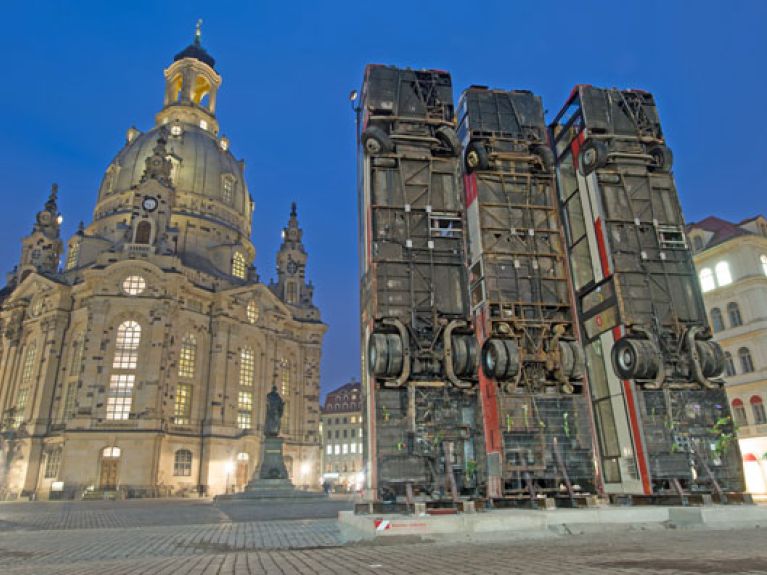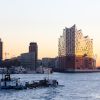A striking work of art
An art installation consisting of three upended buses links the destruction of Dresden in 1945 with today’s civil war in Syria.

Three buses propped up vertically next to Dresden s Frauenkirche church – a scene you would usually expect to see at a construction site or a scrap yard for disused vehicles. In fact, it is a sculpture entitled “Monument” and comes from the German-Syrian artist and Dresden School of Fine Arts graduate, Manaf Halbouni. Until the 3 April 2017 the three buses on Dresden s Neumarkt will recreate the barricade built by the people of Aleppo in 2015 to protect them from sniper fire. Photos of the makeshift barricade in Aleppo went viral around the world.
With the sculpture Dresden has created a symbol for peace, freedom and humanity. During the Second World War Dresden was completely destroyed by Allied bombing on 13 February 1945. The artwork, which is part of a long-term cultural festival on the topic of “arrival”, makes a stark reference to current theatres of war and places at the centre of the movement of refugees such as Lampedusa.
Reaching out to each other
“While in Dresden many wounds have been healed and scars formed, we see bombed-out ghost towns on Europe s doorstep,” says Dresden’s Mayor Dirk Hilbert. “Humanity also means not shutting yourself away in remembering your own past suffering but also reaching out to those for whom the bombs have taken everything.”
In order to create the installation disused German buses were bought and then mounted onto concrete plinths with the aid of structural engineers and architects. As the artist Halbouni explains, the memorial commemorates war and forced migration as well as promoting peace. “It should also remind us of how fortunate we are here and how hard we fought to rebuild the cities here.”
The project is a joint initiative between the Kunsthaus Dresden and the Societaetstheater and partly financed by the Stiftung Kunst & Musik für Dresden, a Dresden-based arts foundation, as well as the East German Sparkasse Foundation. According to the Kunsthaus Dresden the artist Manaf Halbouni will receive no payment for his work.
The route to reconciliation
“Monument” has gained a great deal of attention given its close proximity to the once destroyed Frauenkirche church, where rebuilding work was only completed in 2005. Nevertheless, critics have voiced their concern that it diminishes the memory of those who lost their lives in Dresden because of its focus on Aleppo. The Dresden Frauenkirche Foundation praised the project calling the installation a “symbol of remembrance” which “urges a firm belief in a new beginnin”. “Manaf Halbouni erecting his artwork ‘Monument’ on Dresden s Neumarkt near the Frauenkirche causes seemingly separate worlds to come closer together: Aleppo and Dresden, Syria and Germany, war and peace,” says the Frauenkirche s Reverend Sebastian Feydt. With its “imposing silence” the installation serves as a powerful reminder “not to look away from the suffering of people whose lives and existence are threatened.” Furthermore, the artwork sends another important message – given its location close to the Frauenkirche, “just as the Frauenkirche was rebuilt in the spirit of peace and reconciliation, so too can something new emerge in Syria and other war-torn countries in the world: when erstwhile enemies reach out to each other and take the road to reconciliation.”
©www.deutschland.de

